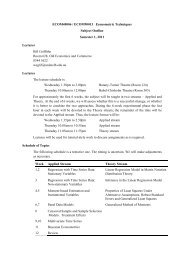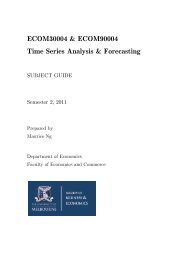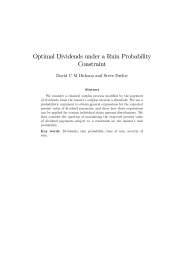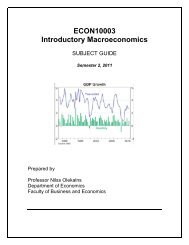A Model of Optimal Corporate Bailouts - Faculty of Business and ...
A Model of Optimal Corporate Bailouts - Faculty of Business and ...
A Model of Optimal Corporate Bailouts - Faculty of Business and ...
You also want an ePaper? Increase the reach of your titles
YUMPU automatically turns print PDFs into web optimized ePapers that Google loves.
(BB ′ ) is thenz + e ∗ 1·T 1 + (1 − e ∗ 1 )·e∗ 2·T 2 ≥ (1 − e ∗ 1 )·g.We let the distortionary cost <strong>of</strong> raising general tax revenue be linear in revenues, i.e., k(z) = a·z,where a > 0. We can then show the following:Theorem 4 If the firm’s (IR) condition is satisfied 22 <strong>and</strong> a bailout is socially desirable, the optimalfunding policy sets T ∗ = 0 <strong>and</strong> consists <strong>of</strong> (i) only general taxation, z = g·[1 − R/(2·c], if a ≤ a,2(ii) only firm-level taxation, T 1 = T ∗, if a ≥ a, <strong>and</strong> (iii) both firm-level taxation, T 1 1, <strong>and</strong> generaltaxation, z, if a ∈ (a, a) where<strong>and</strong>a = 2·c·R + 4·c·(S + I 2) − 3·R 2 /2 − 2·R·S= S + R − 3·R2 − R·S + I 2 8c 2·c 24·c·(R − I 2 ) + R 2 R − I 2 + R24·ca = 2·c·(R + T ∗) + 4·c·(S + I 1 2) − 3·R 2 /2 − 2·R·S, =4·c·(R − I 2 ) + R 2 − 8·c·T ∗ 1T1∗ + S + R − 3·R2 − R·S + I 2 2 8c 2·c 2R − I 2 + R24·c − 2T ∗ 1<strong>and</strong> T ∗ 1 is defined in Theorem 1. If a ∈ (a, a) the optimal firm-level taxation, T 1, is decreasing inc, S, <strong>and</strong> I 2 ; increasing in a; <strong>and</strong> increasing in R for large R <strong>and</strong> large a but decreasing in R forsmall R <strong>and</strong> small a.The pro<strong>of</strong> is in Appendix A.9. If social externalities (S) are large, then failure in either stageis more costly. If restarting costs (I 2 ) are large, then failure in the first stage is more costly. Ineither case, it is then better to tax more externally rather than reduce effort incentives by taxingfirms. In contrast, if a is large, then external taxation is more expensive than firm taxation <strong>and</strong>should be avoided.,4.4 Bailout Recipients, Hold Ups <strong>and</strong> LobbyingIn our model, the optimal bailout infuses just enough capital to induce reinvestment by thefirm, essentially ensuring its continuation pr<strong>of</strong>its are zero. It is conceivable that some firms maysimply turn down the bailout <strong>and</strong> refuse to reinvest, holding out for larger transfer paymentsfrom the government. This danger may be particularly acute for “too big to fail” firms (e.g.,Citibank, Bank <strong>of</strong> America), where S is also known to be very high.We could adapt our model to assume that the bailout recipient firm is able to hold outfor some fraction <strong>of</strong> the total available public surplus, sv 2 . Introducing such hold ups intothe model would have negative welfare effects, because it sharpens the government’s budgetconstraint, <strong>and</strong> reduces firms’ incentives to avoid bailouts. In turn, such hold ups would requirethe government to levy a larger first-period tax on successful firms, thereby diluting firms’22 Introducing general tax revenues slackens the firm’s (IR) constraint, i.e., more projects will now be fundedinitially because firm-level taxes are (weakly) lower.26
















